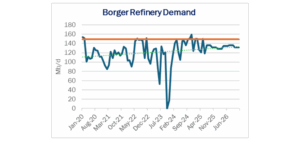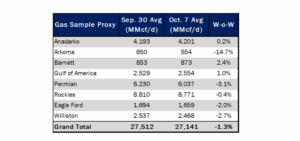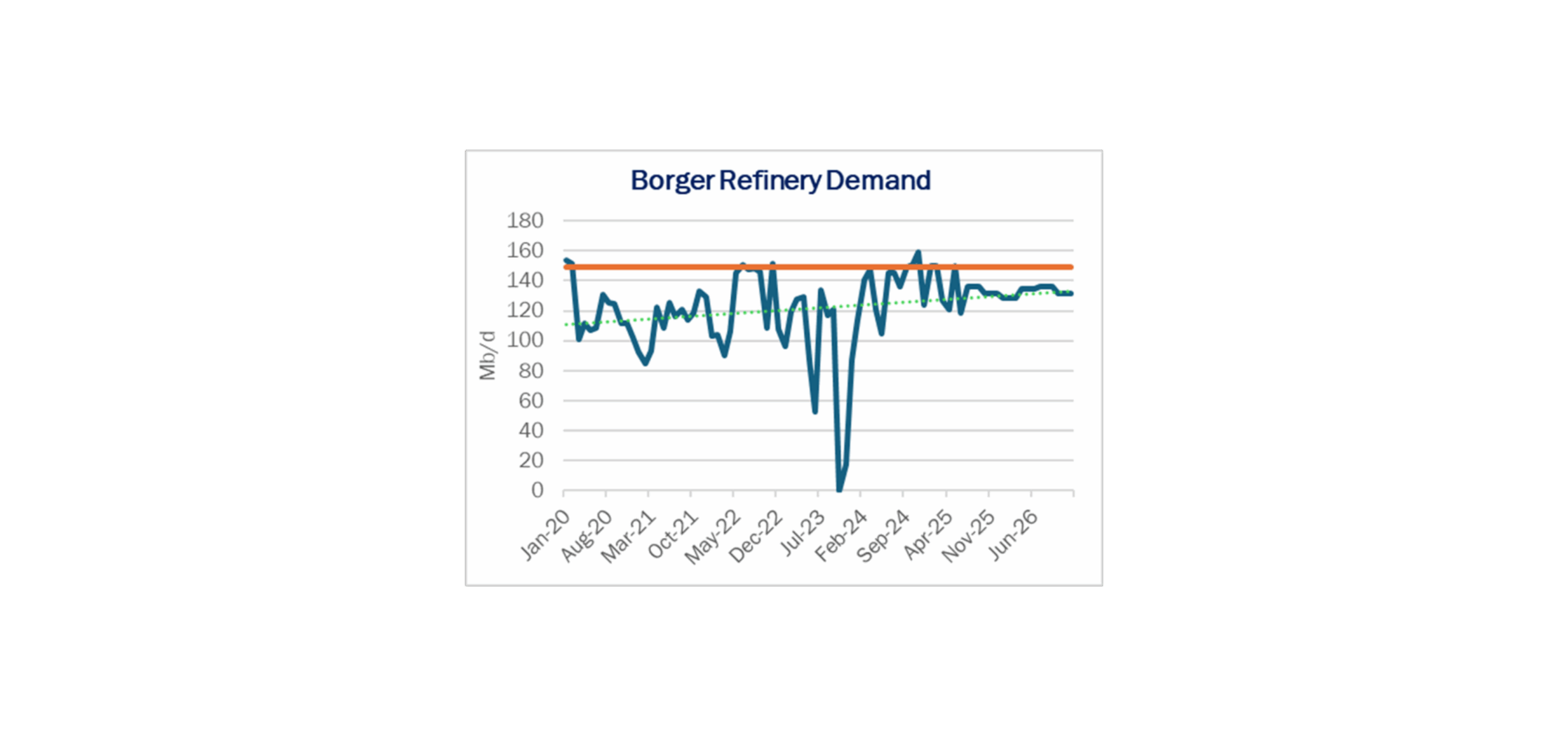Executive Summary:
Rigs: The total US rig count decreased during the week of Oct. 12 to 516.
Infrastructure: FourPoint Resources has reached an agreement with Energy Transfer (ET) to double the size of the Price River Terminal in Wellington, UT as competition heats up to move crude oil from the Uinta Basin.
Supply & Demand: The US natural gas pipeline sample, a proxy for change in oil production, increased 0.3% W-o-W across all liquids-focused basins.
Rigs:
The total US rig count decreased during the week of Oct. 12 to 516. Liquids-driven basins lost 3 rigs W-o-W from 398 to 395.
- Permian:
- Delaware (-2): Petro-Hunt, ConocoPhillips
- Midland (-1): Fasken Oil & Ranch
- Powder River (-1): Occidental Petroleum
- Anadarko (-1): Shakespeare Oil
- DJ (+1): Chevron
- Eagle Ford (+1): Pursuit Oil & Gas
Infrastructure:
FourPoint Resources has reached an agreement with Energy Transfer (ET) to double the size of the Price River Terminal in Wellington, UT as competition heats up to move crude oil from the Uinta Basin.
Under the agreement announced Oct. 9, the partners will build a continuous loop track to improve rail logistics, plus a railcar rack capable of loading 140 Mb/d of crude oil. The project will add nine new rail loading arms, four new truck offload lanes, and construct a heated storage tank with 140 Mbbl of capacity. The companies expect to complete the expansion by 4Q26.

ET owns 55% of the Price River Terminal, located southeast of Salt Lake City on the western edge of the Uinta. Under the agreement, FourPoint will take 50 Mb/d of capacity in the expanded terminal. The Denver-based producer has steadily run 1-2 rigs in the Uinta since 4Q24, according to the “Producer to System Analysis” dashboard in Energy Data Studio.
The Price River project will compete directly with Wildcat Midstream’s expansion of the Wildcat Terminal near Helper, UT. Wildcat, northwest of Price River Terminal, plans to install additional unloading bays, upgrade loading systems and build a dedicated tank farm. The project will increase loading capacity from 20 to 100 Mb/d just next door.

Since 2020, Uinta production has been on the rise, averaging ~276 Mb/d in 2Q25. East Daley’s Production Scenario Tool (PST) in Energy Data Studio projects 3.2% Y-o-Y production growth in 2026. The basin in northeastern Utah has longstanding takeaway constraints, limiting demand to local refineries near Salt Lake City and some railing capacity. Expansions like the Price River and Wildcat projects are critical to enable future growth from the basin.
Along with the terminal expansion, FourPoint announced a rebranding of the Uinta’s unique crude oil. Going forward, FourPoint will market the crude as “American Premium Uinta (APU),” changing the name from Uinta Wax. Uinta crude has some of the highest paraffinic content among US crude oil streams, but is also low in impurities like sulfur and metals.

The Permian Basin at a Crossroads: Download the Latest White Paper
The Permian Basin is the heart of the US energy industry, supplying half of crude oil and NGL production and nearly 20% of natural gas. Yet market pressures are forcing changes, prompting billions in new pipeline investments and reorienting how operators approach the storied basin. East Daley’s new white paper, The Permian Basin at a Crossroads, is the first of a 3-part series looking at the shifts underway in the Permian. In this series, we reveal how LNG demand and AI data centers could transform Permian gas into a primary revenue driver. We also review the multi-billion-dollar infrastructure needed to unlock this shift, and what’s at stake for oil, gas and midstream operators. — Click here to download the The Permian Basin at a Crossroads white paper!
Supply and Demand
The US natural gas pipeline sample, a proxy for change in oil production, increased 0.3% W-o-W across all liquids-focused basins.

The Anadarko, Williston and Barnett basins decreased by 1%, 4.3% and 18.3% respectively. These decreases coincided with increases in the rest of the basins. Samples rose across Texas. The Gulf of America sample increased 2.9%, the Permian increased 4.9% and the Eagle Ford increased 2.4% W-o-W. The Rockies and the Gulf of America have a high correlation between gas volumes and crude oil volumes, whereas the Permian and Eagle Ford basins correlation is less than 45%.
As of Oct. 23, there was ~1,800 Mb/d of refining capacity offline for planned maintenance. This week, additions to planned maintenance occurred with 430 Mb/d from BP’s Whiting refinery and 120 Mb/d from ExxonMobil’s Baton Rouge refinery.
Vessel traffic monitored by EDA along the Gulf Coast increased W-o-W. There were 24 vessels loaded for the week ending Oct. 25 following 21 the week prior.

Regulatory and Tariffs:
Presented by ARBO
Tariffs:
Gray Oak Pipeline, LLC: Certain available capacity discounts were increased.
Magellan Pipeline Company, L.P.: The tariffs were revised to add a new product and to update the product grade document to be consistent with ONEOK’s product grade documents.
The above information is provided by ARBO’s Oil Pipeline Tariff Monitor. For more information on regulatory proceedings or tariff rates, please contact please contact Corey Brill via email at [email protected] or phone at 202-505-5296. https://www.goarbo.com/


